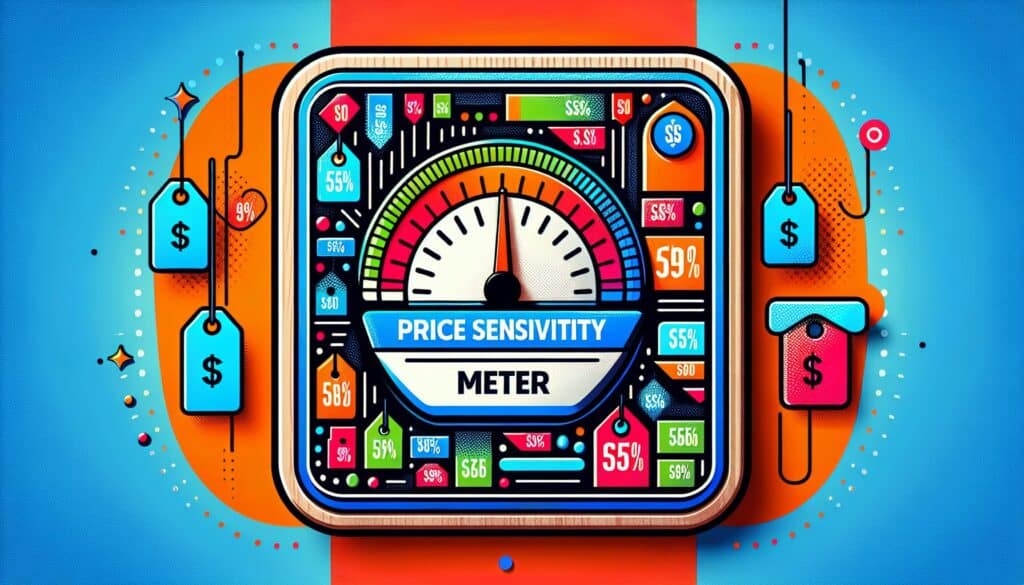Ermittlung einer Bandbreite psychologisch akzeptabler Preise für ein Produkt, indem den Verbrauchern vier spezifische preisbezogene Fragen gestellt werden.
- Methodologien: Ergonomie
Van Westendorp Preisempfindlichkeitsmessgerät (PSM)

Van Westendorp Preisempfindlichkeitsmessgerät (PSM)
- Wettbewerbsanalyse, Verbrauchererfahrung, Customer Journey Mapping, Marktforschung, Produktentwicklung, Produktmanagement, Produktpreisgestaltung, Wert-Angebot
Zielsetzung:
Wie es verwendet wird:
- Die Befragten werden gefragt, zu welchem Preis das Produkt zu haben wäre: 1) so billig, dass man an der Qualität zweifeln würde, 2) ein Schnäppchen, 3) langsam teuer und 4) zu teuer, um es in Betracht zu ziehen. Die Schnittpunkte der Antworten geben einen optimalen Preispunkt und eine akzeptable Preisspanne an.
Vorteile
- Bietet eine Bandbreite akzeptabler Preise, ist leicht zu verstehen und umzusetzen und hilft, Preisschwellen zu ermitteln.
Nachteile
- Misst nicht direkt die Kaufabsicht bei bestimmten Preisen, die Ergebnisse können durch die Vertrautheit der Befragten und den Kontext beeinflusst werden, berücksichtigt nicht die Preise der Wettbewerber.
Kategorien:
- Kunden & Marketing, Wirtschaft
Am besten geeignet für:
- Verständnis der Preiswahrnehmung der Verbraucher und Ermittlung einer akzeptablen Preisspanne für ein neues oder bestehendes Produkt.
The Van Westendorp Price Sensitivity Meter (PSM) is particularly effective during the early stages of product development, especially in industries where pricing strategies significantly influence market success, such as consumer electronics, fashion, and food products. This methodology can be initiated by market research teams or product managers who seek to understand the pricing dynamics in relation to consumer expectations. It often complements other pricing strategies like the Gabor-Granger technique, where more quantitative data can be derived from willingness-to-pay questions that involve actual purchase scenarios. PSM facilitates a qualitative exploration of consumer attitudes towards price, enabling designers and engineers to position their products effectively. For example, in the automotive industry, applying PSM during the conceptual phase can aid in evaluating how consumers perceive the pricing of new electric vehicles relative to traditional options, which can be critical for market acceptance. The interactive nature of PSM allows for engagement with diverse consumer segments, ensuring that the resulting data reflects a wide range of price acceptance, which is particularly valuable in industries subject to rapid change or heavy competition. Collaboration among marketing, sales, and product development teams is often recommended, which can lead to more informed decision-making and alignment on pricing strategies that meet both market demand and financial objectives. Additionally, employing PSM can reveal nuances in consumer psychology, informing branding strategies and communication around price, which are essential when launching premium products.
Die wichtigsten Schritte dieser Methodik
- Ask respondents to provide the lowest price at which they would doubt the product's quality.
- Request the price they would consider a bargain for the product.
- Inquire the price point they feel is getting expensive.
- Determine the price at which the product would be too expensive to consider.
- Analyze the intersections of the price points to identify an optimal price and acceptable range.
Profi-Tipps
- Collect qualitative feedback alongside PSM data to understand the rationale behind price perceptions and thresholds.
- Conduct follow-up analysis to examine how external factors, such as competitors and market trends, influence price sensitivity and consumer behavior.
- Implement iterative testing by adjusting price points after initial PSM findings to refine pricing strategies based on real-world consumer responses.
Verschiedene Methoden lesen und vergleichen, Wir empfehlen die
> Umfassendes Methoden-Repository <
zusammen mit den über 400 anderen Methoden.
Ihre Kommentare zu dieser Methodik oder zusätzliche Informationen sind willkommen auf der Kommentarbereich unten ↓ , sowie alle ingenieursbezogenen Ideen oder Links.
Historischer Kontext
1960
1980
1983
1990
1995
2000
2010
1950
1980
1980
1986
1994
1995
2000
(wenn das Datum nicht bekannt oder nicht relevant ist, z. B. "Strömungsmechanik", wird eine gerundete Schätzung des bemerkenswerten Erscheinens angegeben)














Verwandte Artikel
Fragebögen zu muskuloskelettalen Beschwerden
Multivariate Tests (MVT)
Mehrfache Regressionsanalyse
Motion-Capture-Systeme
MoSCoW-Methode
Moods Median-Test